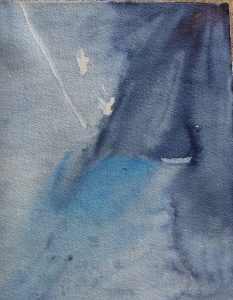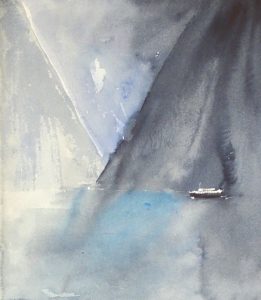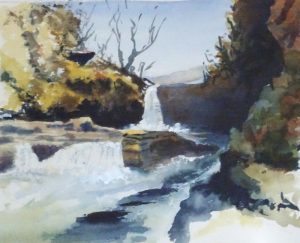It’s all very well to try someone else’s technique, but apart from the fun one should explore it to see what, if anything, one can do with it from one’s own inspiration. I loved the looseness of the style – the blending, swirling, bleeding, thinning of the watercolour paint are integral to its magic.
I think in last week’s effort, I tried to define the picture too soon. The straight line of the water’s edge was too definite, and since it crossed the page from edge to edge, was far too dominant. The real dominance should be the brooding cloud and the bright sea. Then again, the lighter hillside was in advance of the darker one, and while that is not necessarily a design fault, in this case, I think it is . And finally. I think the Indigo needed a bit of warmth added.
 Taking that analysis as my starting point, I tried again. Certainly, start with deep Indigo in the top corner, but instead of clean water as my diluent I used Ultramarine Blue, again stopping the diagonal flow but allowing the darker Indigo to cross it. Lots of water near the shore line, then introduce Manganese Blue fairly strongly in the middle without defining that shore line for its full length. It’s hard to resist the impulse to fiddle as you can see from the bottom of the painting! But I feel this is an improvement on the last one. It allows for the addition of a few details when the painting is completely dry.
Taking that analysis as my starting point, I tried again. Certainly, start with deep Indigo in the top corner, but instead of clean water as my diluent I used Ultramarine Blue, again stopping the diagonal flow but allowing the darker Indigo to cross it. Lots of water near the shore line, then introduce Manganese Blue fairly strongly in the middle without defining that shore line for its full length. It’s hard to resist the impulse to fiddle as you can see from the bottom of the painting! But I feel this is an improvement on the last one. It allows for the addition of a few details when the painting is completely dry.
Duly added. I think this is a reasonable result. I introduced more Ultramarine Blue in the sky and put in the steamer. I also defined the plunging mountain more carefully so that the lighter one does go behind it. There is a very fine line defining the shore in front of the boat . The painting is not as dark as the first image suggests so I lightened the photo and this has enhanced the image! There’s a feeling of moving towards the light.
I think this is a reasonable result. I introduced more Ultramarine Blue in the sky and put in the steamer. I also defined the plunging mountain more carefully so that the lighter one does go behind it. There is a very fine line defining the shore in front of the boat . The painting is not as dark as the first image suggests so I lightened the photo and this has enhanced the image! There’s a feeling of moving towards the light.
I’m going to explore further next week but I’m using one of my photos from Australia. I’ll look for something less gloomy.




